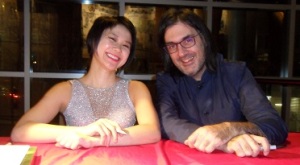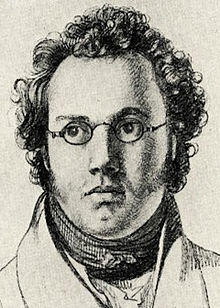
Yuja Wang and Leonidas Kavakos at the post-concert reception, Feb. 10, 2017.
Earlier this month, Leonidas Kavakos and Yuja Wang gave their first joint appearance in Seattle in a recital that will long be remembered by those fortunate enough to attend. Their recital happened to fall on Ms. Wang’s birthday, but it was the audience that received a present: a program of music that, while by no means esoteric, was certainly lesser known, and just as certain to expand and enrich the musical lives of everyone in attendance.
I had lingering reservations about attending this recital, reservations that had nothing to do with the program or with Leonidas Kavakos, whom I had heard perform with the Seattle Symphony Orchestra in 2006, and whom I featured on this blog two years ago in a performance of the Korngold violin concerto. My concerns were related solely to Yuja Wang, who, while she possesses a virtuoso technique, seems often in her programs to emphasize style over substance, and whose attire seems inevitably to distract the viewer from the music and overshadow her musicianship. For an in-depth discussion of the style vs. substance dichotomy as it relates to Ms. Wang, I refer the reader to this article from the Sept. 5, 2016 issue of The New Yorker.
My concerns about Ms. Wang’s attire vanished the moment she appeared on stage, wearing an elegant, floor-length, off-white gown that would have passed muster in even the most conservative of concert settings. Relieved that I would be able to focus all my attention on the music, I settled back to enjoy the first piece on the program: the Violin Sonata by Leoš Janáček. This is an exceptionally passionate work, one that both challenges and rewards the listener. The second movement is especially tender, and was the high point of the sonata for me. Mr. Kavakos and Ms. Wang clearly see themselves as servants of the music, and surely won many new friends for Janáček with this performance.
After the passion of the Janáček, I was grateful for the peaceful opening of Schubert’s Fantasie in C major. In the playful second movement, Wang and Kavakos demonstrated ensemble playing of the highest order. The song-like third movement reminded us once again of Schubert’s unsurpassed gift for melody, and filled the concert hall with the same spiritual ambiance one might feel in a cathedral. Despite the diverse character of the four sections of the last movement, it felt unified from beginning to end, and the main theme of the Allegro vivace conveyed a surpassing joy.
The second half of the program began with Debussy’s Violin Sonata in G minor. Composed in 1917, this sonata was Debussy’s final major work. Unlike the other pieces on the program, all of which deserve a wider audience, this sonata has been a staple of the violinist’s repertoire from the beginning. When Ms. Wang played the two soft chords with which it begins, and which carried beautifully all the way to my seat in the third tier, I was struck at once with the thought, “What a touch!” Later, reflecting on the performance as a whole, I noted, “Just wonderful playing!”
The final work on the program was Bartok’s Violin Sonata No. 1 in C-sharp minor. This sonata was composed in 1921, and I cannot hear it except as a reaction to the horrors of World War I. The first movement, marked allegro appassionato, burns white-hot from the very first notes. Both players need a huge technique to carry off this piece. The second movement, adagio, conveys utter desolation. All is lost. Kavakos and Wang adopted a more relaxed tempo in this movement than one sometimes hears, which added to the sense of desolation. The third movement, marked allegro, is simply breathtaking: a 19th century friska in 20th century garb, building to an overpowering climax as it speeds to the finish.
The effect was overwhelming. The audience loved it, and gave Kavakos and Wang an enthusiastic standing ovation. In return, they gave us one encore, the graceful Andantino from Schubert’s Violin Sonata in A Major, D. 574, which, coming after the Bartok, may have been as necessary (for audience and performers alike) as cooling out a horse after a race.
All in all, it was an extraordinary recital, notable both for the artistry of the performers and the seriousness of the program. There were no Kreisler transcriptions, no Carmen Fantasy. Even the encore was not your typical crowd-pleaser. There were no lollipops anywhere. Instead, Kavakos and Wang gave us a four-course feast for the musical soul. I look forward to their next banquet here.
Derrick Robinson




